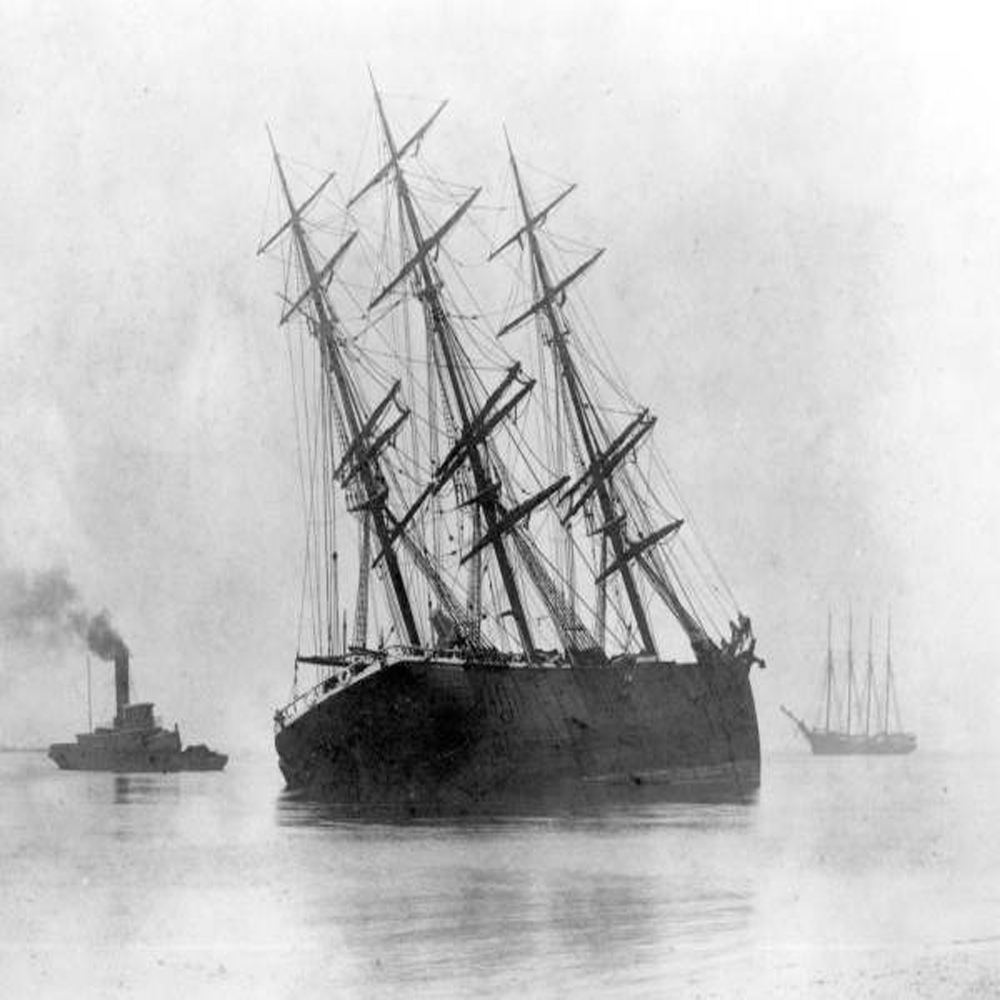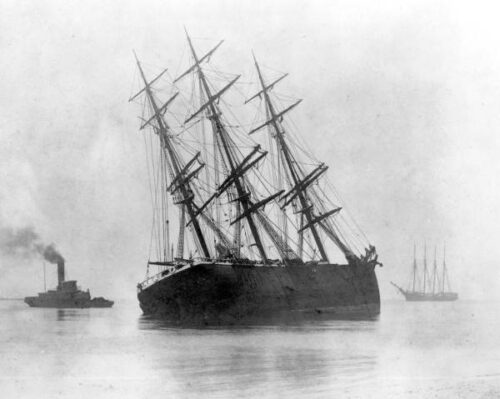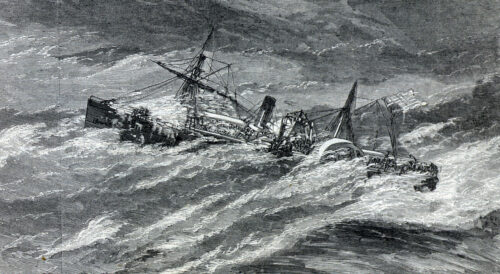
Amelia Island’s Shipwrecks
February 6, 2023by Samantha Rizzo
The waters off Florida are home to hundreds of shipwrecks. From Spanish galleons to Civil War blockade runners to passenger ships to personal fishing boats, the seafloor is littered with the skeletons of destroyed vessels that never reached their destinations. Amelia Island and the waters around it are no exception. While many people’s first thought associated with shipwrecks is lost treasure, it is key to remember that not all wrecks contain gold or silver, but are a gold mine of information and artifacts from the past. It’s also important to consider that while for us shipwrecks may be amazing relics of the past or fun dive spots, for those who were aboard these ships when they went down and were unable to escape, these are their final resting places.

The ship “Ruby” aground off Quarantine Station – Fernandina, Florida. 1908. State Archives of Florida, Florida Memory. https://www.floridamemory.com/items/show/37858.
One of the most famous fleets to sink off the coast of Florida was the 1715 Tierra Firme, a squadron of eleven treasure ships. Of these eleven, only four survived the hurricane that wiped out the rest of the fleet. These included the Concepción, the San Miguel, and the Ciervo, which were thought to have sank shortly after the hurricane, as they never reached their destination of Spain.
The fourth was the French ship Grifon, the only ship to make it back to Europe. The majority of the fleet was discovered by treasure hunter Kip Wagner in the 1960s. The San Miguel may have actually sank off the coast of Amelia Island, if eyewitness testimony and the discovery of gold coins is to be believed. Wagner discovered over twenty gold esudos (coins) while searching for treasure on one of Amelia Island’s beaches in 1975. While this alone doesn’t mean that the ship sank close to the island, eyewitness accounts point towards the San Miguel sinking somewhere near the island. Eyewitnesses reported that they saw the San Miguel north of St. Augustine, missing its mast but having survived the storm that wiped out much of the fleet. This would place it in an area close to Amelia Island. Until it is discovered, the treasures aboard will remain hidden under the waves.
Not all of Amelia’s shipwrecks were Spanish treasure ships. Around 44 shipwrecks are recorded in the waters around the island. One of these shipwrecks was the Olivette. A steamship-turned-hospital ship during the Spanish-American War, she had arrived in Fernandina with the purpose of transporting the sick to a hospital in Virginia. While docked at a quarantine station on August 31st, 1898, she suddenly sank due to stormy weather, during which, “…she listed heavily, filled with water, and sank in 20 feet of water.” Luckily, everyone aboard survived.
Another wreck involved a Civil War era steamship. Found as two separate wrecks while dredging a new channel leading to the ammunition depot harbor at St. Marys, Georgia, the ship’s name and purpose are unknown. What is known, however, is that it was converted from a sailing vessel to a steamship. The remains of the ship’s boiler suggested an explosion, but due to the ship’s being broken in two and found in two separate wreckage sites, it is believed that the ship was destroyed by an explosion caused by ammunition igniting as a result of a boiler explosion.

“Sinking of the S.S. Evening Star in the Atlantic, October 3, 1866, artist’s impression,” House Divided: The Civil War Research Engine at Dickinson College, https://hd.housedivided.dickinson.edu/node/45724.
There is one wreck in particular that didn’t sink off Amelia Island, but is directly tied to Fernandina’s history. The wreck of the Evening Star predated the Titanic by about 50 years and was known as the “greatest maritime disaster of its time,” but has somehow been forgotten by many. Up until the sinking of Titanic, the Evening Star, a passenger steamer bound for New Orleans from New York, was considered the worst maritime tragedy in America.
Carrying around 300 people total, 14 of which were crew, the ship was hit by a hurricane about 180 miles off Tybee Island, Georgia on October 2nd, 1866. Similar to the Titanic, there weren’t enough lifeboats for everyone aboard, and when “abandon ship” was called, there was chaos. The steamship carried six lifeboats with room for ten people each, meaning if all were launched completely full, only 60 people would make it out on lifeboats—and this is only if all six made it into the water. Due to the storm, only four of the lifeboats made it to the water, all of which capsized multiple times. Of these four, one eventually sank, two drifted for about two days until they were rescued by a passing ship, and the fourth made a five-day journey ending on Amelia Island. This lifeboat initially carried 11 people aboard—six passengers and five sailors—but would come ashore near Fort Clinch with only six survivors, of which only one was a passenger.
This passenger, Frank Girard, was nursed back to health by the mayor of Fernandina, Samuel T. Riddell, and his family, and later went on to chronicle his experience in the book A Detailed Account of the Loss of the Steamship ‘Evening Star,’ Lost at Sea, October 3rd, 1866. According to Girard, when he first climbed aboard the lifeboat, one of the crew members attempted to stop him, only to drown when the boat capsized. Another threatened to “brain him” with a piece of wood should he help a woman climb aboard. Girard was one of only 17 survivors out of the 300 people aboard the Evening Star, surviving not only the wreck but also five days at sea and a contusion to his leg. Despite the small number of lifeboats, it wouldn’t be until after the Titanic sank for ships to be mandated to carry enough lifeboats for everyone aboard.
References:
Drane, Hank. “From the Ocean Floor Is Dredged a Fragment of Florida’s History.” Florida Times-Union, June 2, 1957.
Edenfield, Gray. “Wreck of the Evening Star.” News-Leader, January 18, 2013.
Girard, Frank. A Detailed Account of the Loss of the Steamship ‘Evening Star,’ Lost at Sea, October 3rd, 1866. Boston: Boston Job Print House, 1881.
“Olivette Sinks at Anchor.” New York Times, September 1, 1889.
“Report of the Surgeon-General of the Army to the Secretary of War for the Fiscal Year Ended June 30, 1889.” History of the Office of Medical History, 1898.
Scanlan, Dan. “Silver Coin could be Evidence of Missing Spanish Ship.” Florida Times-Union, June 2, 2014.
Schlichter, Jay. “Seeking the San Miguel.” The News-Leader, October 22, 1997.
Singer, Steven D. Shipwrecks of Florida: A Comprehensive Listing. Sarasota: Pineapple Press, 1998.





